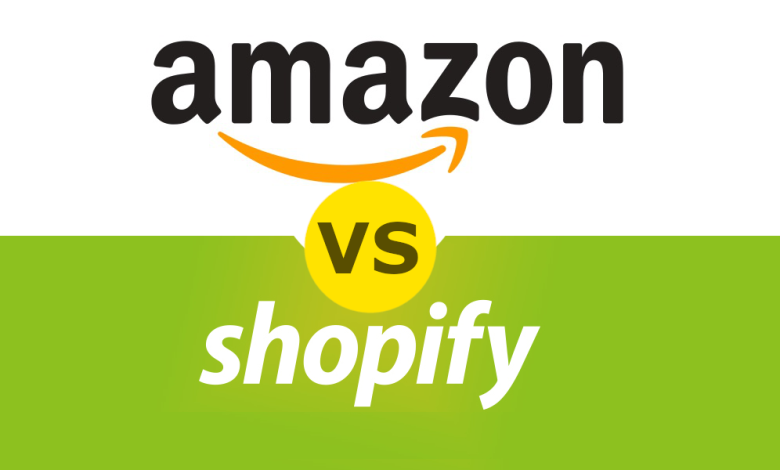Shopify vs Amazon – Which One to Build & Drive Your Business?

The main target for a business owner is to decide what e-commerce platforms are better to sell the goods online. Both Shopify & Amazon are the biggest names in the e-commerce world. However, both have their plus and minus.
Choosing Amazon over Shopify offers a huge audience to you without doing any marketing. But by using Shopify one can have whole ownership that involves consumer experience, layout, and branding. Looks confused, doesn’t it? Let’s have bigger pictures of these two in a more detailed way.
What is Amazon?
Amazon is a widely known e-commerce marketplace. Being the primary marketplace in the market, it’s used across the world. Being a well-known marketplace, Amazon lets brands list items online via their network. Sell over Amazon with a pro or individual account. You can look for many parties of items in one place. Due to Amazon’s reputation, customers are already in line to choose it. So, it’s a better way to please a significant consumer base
What is Shopify?
Shopify is another popular eCommerce platform for all brands to build online stores. This platform offers a wide variety of features to customize. It’s a cloud-based platform that works over a subscription-based model. That provides access to anything you spend in the subscription. Shopify once could manage every eCommerce functionalities, from store design to secured payments, and product listings for the online stores.
1. Pricing Plans
The main thing you need to look at deeper while choosing e-commerce platforms is their pricing. Rather than the normal pricing plan, these e-commerce platforms also come with upfront costs, credit card fees, and transaction fees. That might raise monthly outgoings.
Amazon
Amazon features Amazon Pay as its payment gateway. It lets you accept debit and credit cards however not PayPal. Amazon provides a selling fee with a monthly subscription for the sellers. For expert Sellers, amazon offers selling fees + monthly subscriptions.
If you go with Amazon FBA then the price varies from $2.41 – $137.32 form There is an inventory storage fee that costs $0.69 – $2.40 monthly. These are based on store volume, size, product, and more. By the way, individual sellers don’t need to invest in monthly subscriptions as Professional Sellers. You would be charged a $0.99 fee for each item that you sell.
Shopify
Coming to Shopify it features its own Shopify has its payment gateway. If you are using that, then Shopify doesn’t charge you with transaction fees. Shopify offers more than 100 payment gateways that involve Paypal and Amazon Pay.
These charge type transaction fees from 0.5% – 2% based on what plan you are on. The credit card chapter is applied to every payment gateway that involves Shopify Payments. The normal credit card rate over Shopify is 2.9% + 30¢. You could upgrade it via Shopify’s price plans so the credit card rates lessen from 2.9% with 30 cents – 2.4% with 30 cents.
Shopify offers more payment choices to choose from than Amazon. One need not pay transaction fees while utilizing Shopify Pay. Price plan seems to be dependent. A Shopify agency can decide what plan your business needs.
2. Ease of Use
You would offer a smooth selling experience to your customers through the eCommerce platform. To be honest, both Amazon and Shopify are simple to use and straightforward processes.
Shopify
To set up a Shopify store no coding skills are required. All you need is a drag-and-drop feature. From where you can build a successful Shopify store. Firstly, create a Shopify account then start with managing and changing text, colors, and layout. You can also drop or media things anywhere on the page. With its instinctive interface, you can never lose while creating an online store. Shopify’s backend dashboard is simple to explore as it displays everything you mean on the left sidebar.
Amazon
To build a business on Amazon, you should follow setup levels to register for an Amazon account. Then upload product details that display product identifiers, product category, product info, search terms, and more. Amazon offers excellent tools that make selling straightforward. For instance, to look after shipping you could use the Amazon e-commerce tool FBA
3. eCommerce Features
Checking out Ecommerce features before choosing an Ecommerce platform for running your e-commerce store, is a mandatory process.
Shopify
Shopify product management lets you add new products over the back-end interface. It can import CSV files. Fill in the product info and assign product categories to the products.
With Shopify’s inventory tracking system, you could manage inventory efficiently to avoid selling out-of-stock items. Abandoned Cart Recovery is offered by default for every plan. This lets you check in people who abandoned carts with emails.
Amazon
You could include products solely with Amazon interactive listing features. Amazon offers Inventory File Templates too. So now adding variants to the products while including these in the seller account becomes easy. Still, you could just sell physical products which couldn’t be shipped as Amazon accessed to sell content that can be downloaded.
Amazon also offers several tools to benefit online selling. You could utilize FBA to make Amazon deal with the shipping, packaging, and storage of the products. With the Amazon FBA, you can send items to Amazon’s storage. If a customer buys products, then Amazon can pack them & ship them to you.
Selling with Amazon made it easy. Both Amazon and Shopify have great robust eCommerce tools that help businesses.
4. Design & Customizability
Shopify
Shopify provides a limited number of design & customization options. Here the options are endless. You need to get access to the website admin, where one could pick from more than 60 themes.
After deciding on the theme, you could customize, and arrange it again. Their premium and free themes offer an excellent option to express your style. They provide several extensions which you could include to the site that boosts user experience.
With Shopify, you can pick from more than 70 templates. That you can personalize each element that involves layout, colors, font, and logo that matches your brand’s tone. You don’t need proficiency in HTML. But few people find it tough while build a store. Get Shopify plus agency to build & manage website hassle freely.
Amazon
The page layout is quite consistent. You could submit details and photos. However, the appearance and style of the store page look more like Amazon’s than yours.
The design flexibility of Amazon is more restricted than Shopify. It features a limited array of storefront templates. After choosing a template then you can edit it and include a video to display pictures. It looks similar to an Amazon page. Amazon is far less different than Shopify.
Conclusion
Shopify & Amazon are the top choices to build your e-commerce brand. Each one has its benefits and cons. Go with your business flexibility and goals to choose a platform you need. Along with it think about the time you can spend. And how faster you like to scale the business matters which supports you in deciding what platform you like to go with. Reach a Shopify agency to get a clear understanding of what is best for your website.




